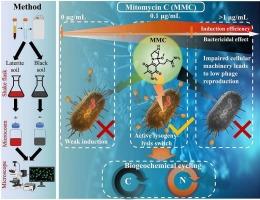丝裂霉素c诱导的原噬菌体活化原位溶原裂解功能动力学研究
IF 5
2区 农林科学
Q1 SOIL SCIENCE
引用次数: 0
摘要
温带噬菌体在溶原性和裂解性循环之间交替进行,是微生物群落和生态系统功能的关键调节因子。然而,土壤中噬菌体激活的生态后果仍然知之甚少。在此,我们建立了一种新的原位丝裂霉素C (MMC)诱导实验,以研究前噬菌体激活对微生物群落和土壤生物地球化学的功能影响。通过MMC浓度梯度,我们确定0.1 μg/mL为最优剂量,可有效诱导噬菌体对非溶原性细菌产生最小的细胞毒性。在黑土和红土土壤中进行的微观实验表明,前噬菌体诱导显著改变了土壤细菌群落组成和多样性,破坏了碳氮循环。具体而言,低剂量MMC处理抑制了氮矿化,而高剂量MMC处理损害了微生物呼吸并减少了CO₂和N₂O排放。这些发现表明,前噬菌体的激活是土壤微生物动力学和养分周转的敏感指标,为温带噬菌体在陆地生态系统功能中的作用提供了新的认识。本文章由计算机程序翻译,如有差异,请以英文原文为准。

Mitomycin C-induced prophage activation for exploring the Lysogeny-lysis functional dynamics in situ
Temperate phages, which alternate between lysogenic and lytic cycles, are key regulators of microbial communities and ecosystem functions. Yet, the ecological consequences of prophage activation in soil remain poorly understood. Here, we developed a novel in situ mitomycin C (MMC) induction assay to investigate the functional impacts of prophage activation on microbial communities and soil biogeochemistry. Using a gradient of MMC concentrations, we identified 0.1 μg/mL as an optimal dose that efficiently induced prophages with minimal cytotoxicity to non-lysogenic bacteria. Microcosm experiments in black and laterite soils revealed that prophage induction significantly altered bacterial community composition and diversity, and disrupted carbon and nitrogen cycling. Specifically, low-dose MMC treatments suppressed nitrogen mineralization, while higher doses impaired microbial respiration and reduced CO₂ and N₂O emissions. These findings demonstrate that prophage activation serves as a sensitive indicator of soil microbial dynamics and nutrient turnover, offering new insights into the roles of temperate phages in terrestrial ecosystem functioning.
求助全文
通过发布文献求助,成功后即可免费获取论文全文。
去求助
来源期刊

Applied Soil Ecology
农林科学-土壤科学
CiteScore
9.70
自引率
4.20%
发文量
363
审稿时长
5.3 months
期刊介绍:
Applied Soil Ecology addresses the role of soil organisms and their interactions in relation to: sustainability and productivity, nutrient cycling and other soil processes, the maintenance of soil functions, the impact of human activities on soil ecosystems and bio(techno)logical control of soil-inhabiting pests, diseases and weeds.
 求助内容:
求助内容: 应助结果提醒方式:
应助结果提醒方式:


